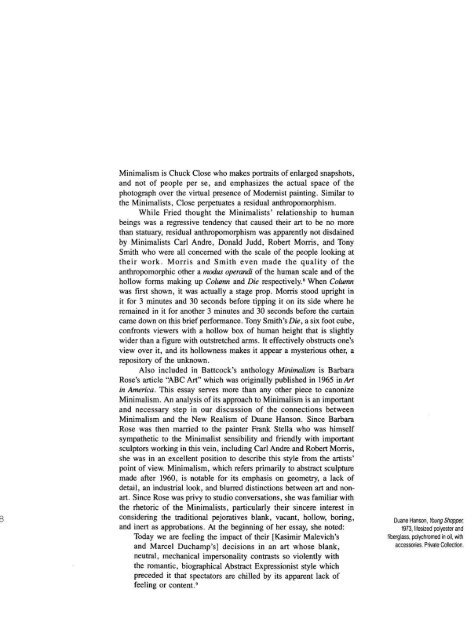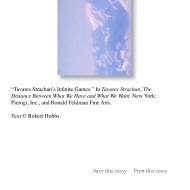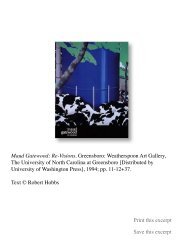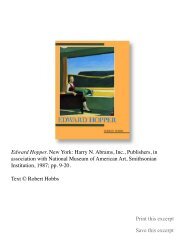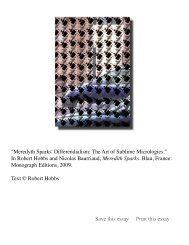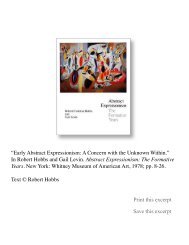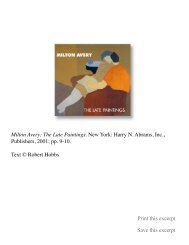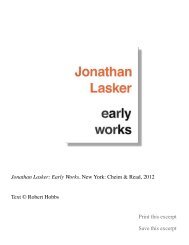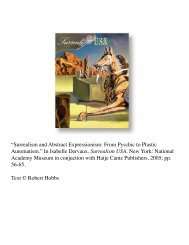Duane Hanson: The New Objectivity. Tallahassee - Robert Hobbs
Duane Hanson: The New Objectivity. Tallahassee - Robert Hobbs
Duane Hanson: The New Objectivity. Tallahassee - Robert Hobbs
You also want an ePaper? Increase the reach of your titles
YUMPU automatically turns print PDFs into web optimized ePapers that Google loves.
Minimalism is Chuck Close who makes portraits of enlarged snapshots,<br />
and not of people per se, and emphasizes the actual space of the<br />
photograph over the virtual presence of Modernist painting. Similar to<br />
the Minimalists, Close perpetuates a residual anthropomorphism.<br />
While Fried thought the Minimalists' relationship to human<br />
beings was a regressive tendency that caused their art to be no more<br />
than statuary, residual anthropomorphism was apparently not disdained<br />
by Minimalists Carl Andre, Donald Judd, <strong>Robert</strong> Morris, and Tony<br />
Smith who were all concerned with the scale of the people looking at<br />
their work. Morris and Smith even made the quality of the<br />
anthropomorphic other a modus operandi of the human scale and of the<br />
hollow forms making up Colwnn and Die respectively. 8 When Column<br />
was first shown, it was actually a stage prop. Morris stood upright in<br />
it for 3 minutes and 30 seconds before tipping it on its side where he<br />
remained in it for another 3 minutes and 30 seconds before the curtain<br />
came down on this brief performance. Tony Smith's Die, a six foot cube,<br />
confronts viewers with a hollow box of human height that is slightly<br />
wider than a figure with outstretched arms. It effectively obstructs one's<br />
view over it, and its hollowness makes it appear a mysterious other, a<br />
repository of the unknown.<br />
Also included in Battcock's anthology Minima/ism is Barbara<br />
Rose's article "ABC Art" which was originally published in 1965 in Art<br />
in America. This essay serves more than any other piece to canonize<br />
Minimalism. An analysis of its approach to Minimalism is an important<br />
and necessary step in our discussion of the connections between<br />
Minimalism and the <strong>New</strong> Realism of <strong>Duane</strong> <strong>Hanson</strong>. Since Barbara<br />
Rose was then married to the painter Frank Stella who was himself<br />
sympathetic to the Minimalist sensibility and friendly with important<br />
sculptors working in this vein, including Carl Andre and <strong>Robert</strong> Morris,<br />
she was in an excellent position to describe this style from the artists'<br />
point of view. Minimal ism, which refers primarily to abstract sculpture<br />
made after 1960, is notable for its emphasis on geometry, a lack of<br />
detail, an industrial look, and blurred distinctions between art and nonart.<br />
Since Rose was privy to studio conversations, she was familiar with<br />
the rhetoric of the Minimalists, particularly their sincere interest in<br />
considering the traditional pejoratives blank, vacant, hollow, boring,<br />
and inert as approbations. At the beginning of her essay, she noted:<br />
Today we are feeling the impact of their [Kasimir Malevich's<br />
and Marcel Duchamp's] decisions in an art whose blank,<br />
neutral, mechanical impersonality contrasts so violently with<br />
the romantic, biographical Abstract Expressionist style which<br />
preceded it that spectators are chilled by its apparent lack of<br />
feeling or content. 9<br />
<strong>Duane</strong> <strong>Hanson</strong>, Young Shoppe~<br />
1973, lifesized polyester and<br />
fiberglass, polychromed in oil, with<br />
accessories. Private Collection.


